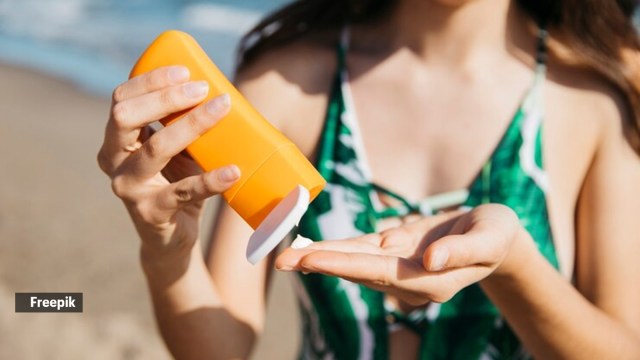📣 For more lifestyle news, click here to join our WhatsApp Channel and also follow us on Instagram
Sunscreen and sunblock are different. Both can protect your skin from UV radiation but…
Sunscreen and sunblock are totally different, know more from the experts.
 Sunscreen and sunblock both protect from the sun, but they work differently. (Source: Freepik)
Sunscreen and sunblock both protect from the sun, but they work differently. (Source: Freepik)Sunscreen and sunblock are distinct sun protection products. According to Dr Mikki Singh, founder and medical director, Bodycraft Clinic, “Sunscreens use chemical ingredients like oxybenzone and avobenzone to absorb UV rays.”
In contrast, sunblock, as explained by Dr Neha S., dermatologist at Grass, forms “a physical barrier with ingredients like zinc oxide and titanium dioxide to reflect and scatter UV rays. Both offer protection, but individuals with sensitive skin may find sunblock less irritating.”
How sunscreen and sunblock work
The terms sunscreen and sunblock are often used interchangeably, but they represent distinct products with different mechanisms of action. Sunscreen, also known as chemical sunscreen, absorbs ultraviolet (UV) radiation through its chemical ingredients, converting it into heat and releasing it from the skin. Dr Singh explained, “Common chemical sunscreen ingredients include oxybenzone, avobenzone, and octinoxate”.
On the other hand, sunblock, or physical sunscreen, creates a physical barrier on the skin’s surface, reflecting and scattering UV rays away from the skin. Zinc oxide and titanium dioxide are the primary active ingredients in physical sunscreens. Dr Neha emphasised, “While both sunscreen and sunblock can effectively prevent tanning, individuals with sensitive skin may prefer sunblock due to its reduced likelihood of irritation”.
To shield oneself from the sun’s harmful rays and the risk of tanning, it is crucial to use a broad-spectrum sunscreen with an SPF of at least 30, as recommended by both experts. Broad-spectrum sunscreens protect against both UVA and UVB rays, which contribute to sunburn, premature aging, and skin cancer.
Melanin and sun protection
Melanin, the pigment responsible for skin color, does offer some natural UV protection. However, its level of protection varies among individuals, and it is insufficient to prevent skin cancer entirely. Both Dr Singh and Dr Neha concurred that the choice between chemical and physical sunscreen does not significantly impact the risk of skin cancer based on melanin levels. Regular and proper application of a broad-spectrum sunscreen with a high SPF remains paramount for everyone, regardless of skin tone.
Individuals with sensitive skin may experience irritation from certain sunscreen ingredients. Dr Singh advised avoiding oxybenzone and octinoxate, which are common in chemical sunscreens, as they can cause allergic reactions. Fragrances, preservatives, and parabens were also mentioned as potential irritants for sensitive skin. Physical sunscreens, particularly those labeled fragrance-free, hypoallergenic, and suitable for sensitive skin, are generally well-tolerated.
 Sunblock, or physical sunscreen, creates a physical barrier on the skin’s surface. (Source: Freepik)
Sunblock, or physical sunscreen, creates a physical barrier on the skin’s surface. (Source: Freepik)
Dr Neha shared that GRASS’s research on whipped sunscreen revealed that oxybenzone and avobenzone should be avoided in formulations for sensitive skin due to their potential irritating effects.
Protecting children’s delicate skin from the sun is of utmost importance. Dr Singh stressed the use of broad-spectrum sunscreen with an SPF of at least 30, reapplied every two hours or more frequently when swimming or sweating. Opting for physical sunscreens with zinc oxide or titanium dioxide is generally safer for infants and children. Additionally, dressing children in protective clothing, seeking shade during peak sun hours, and educating them about sun safety habits are essential preventive measures.
Protecting children from the sun
Dr Neha emphasised, “The importance of applying sunscreen with an SPF of 30 or higher every two to three hours on children, limiting their sun exposure during peak hours, and dressing them in protective clothing”.
Both sunscreen and sunblock offer effective protection against the sun’s harmful rays. The choice between the two depends on individual skin type and preferences. Regular sunscreen use, along with protective clothing and shade seeking, is essential for preventing sunburn, premature aging, and skin cancer. Parents should prioritize sun protection for their children to safeguard their long-term skin health.
📣 For more lifestyle news, click here to join our WhatsApp Channel and also follow us on Instagram
- 01
- 02
- 03
- 04
- 05



























